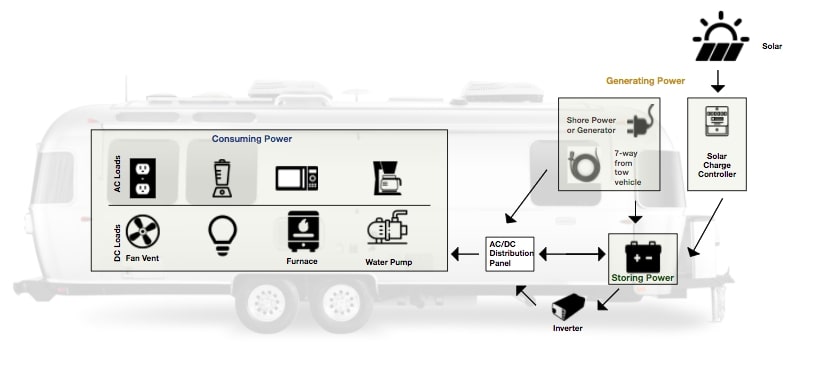This article is part of a series designed to help Airstreamers and prospective owners better understand and utilize their unit’s electrical system. Click here to read other installments in the series.
Airstreams are all about outdoor adventure. They are magic carpets that allow you to explore from the mountains to the prairies to oceans white with foam. And isn’t it great after a day of exploring to come home to your Airstream and relax? Maybe read or watch TV in bed? Or listen to some music on the sound system while charging your phone and tablet? All in the cool of the air conditioning?
Those post-adventure comforts of home are made possible by your Airstream’s remarkable electrical system. Given its importance in nearly every aspect of the Airstream lifestyle, it’s worth taking time to familiarize yourself with how the juice flows through your Silver Bullet.
Taking it Back to Edison versus Tesla
Edison was the father of Direct Current electricity, while his rival Tesla perfected Alternating Current. The AC/DC saga is so fascinating that it has spawned books and movies. But all you really need to know for our purpose is that your Airstream’s electrical system has both AC and DC capabilities.
The 110-volt AC current (just like the electricity found in most residential homes in the U.S. and Canada), usually supplied by shore power or a generator, handles the heavy lifting on appliances like the microwave, anything with an electric heating element, and the air conditioning. The 12-volt DC current supplied by your batteries handles lighter-duty chores like powering the lights, fans, and your electric awning.


Thanks to an ingenious device called an inverter, your Airstream can convert that 12-volt electricity in the batteries into 110-volt AC current for use when you aren’t drawing AC power from an electric hookup or generator. This allows you to enjoy some of the comforts of home while boondocking. The standard inverter provides 1,000 watts of AC power, so you won’t have enough power to run the AC or blend a batch of frozen margaritas. But you will be able to watch some TV or charge your laptop at one of the Airstream’s AC outlets.
Outlets that can supply AC power via the inverter are marked with a blue sticker. When you need to use these outlets, simply press the inverter on/off button, typically mounted above the kitchen counter. To protect your battery power, be sure to turn off the inverter when you’re not using those outlets.
Whether or not you’re into boondocking, it’s a good idea to conduct an energy audit, which estimates how much electricity you need to power your Airstream lifestyle. Knowing how much juice you consume is key to determining how much battery and solar charging capacity you need. The data can also help you manage your energy reserves when you’re off the grid.
“My business is based on energy audits,” says Airstream Ambassador Ronnie Dennis, who installs solar panels and lithium batteries on Airstream products. “People give us an idea of what they want to be able to run. We determine how many Watts that's going to require, and then we put enough solar and enough battery bank in place so the customer can use those items.”
About those batteries…
There are three basic types available for use in your Airstream:
Lithium batteries are the gold standard for RV batteries. They can store more usable energy than a comparable lead acid battery. Like most “best choices,” lithium batteries cost more but, because they last longer than other options — up to 10 years — they ultimately save you money. On the downside, lithium batteries can be slow to charge in cold weather.
The mid-range option is an AGM or Absorbed Glass Mat battery. These maintenance-free lead-acid batteries have a fiberglass mat to absorb sulphuric acid. They typically have a longer life than standard lead-acid batteries but should only be discharged to 50% of their capacity, which means you need more AGM than lithium batteries to get the same capacity.
A lead-acid battery is the cheapest option for your Airstream, but their water levels must be monitored regularly and have a shorter life than lithium or AGM batteries.
For more information about your Airstream’s electrical system, check out the power section of our all-new Airstream Academy customer support resource. This comprehensive knowledge base is jam-packed with answers and information about every aspect of operating and maintaining your Silver Bullet.









